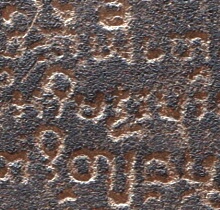 |
   |
 Origin and Development of Southeast Asian Scripts (ODSEAS) Origin and Development of Southeast Asian Scripts (ODSEAS) |
 Hideo SAWADA Hideo SAWADA |
 since June, 2001 since June, 2001 |
 |
   |
 Origin and Development of Southeast Asian Scripts (ODSEAS) Origin and Development of Southeast Asian Scripts (ODSEAS) |
 Hideo SAWADA Hideo SAWADA |
 since June, 2001 since June, 2001 |
 This project is constructing a database concerning the diachronic changes to glyph forms, as well as the structural and ordering variations that are found among different writing systems, by collecting electronic images of written materials (such as inscriptions and manuscripts) that exist in Southeast Asia. This project is constructing a database concerning the diachronic changes to glyph forms, as well as the structural and ordering variations that are found among different writing systems, by collecting electronic images of written materials (such as inscriptions and manuscripts) that exist in Southeast Asia. |
| Members: Hideo SAWADA, Kazuhiko MACHIDA, Jun TAKASHIMA, Makoto MINEGISHI, Asako SHIOHARA, Kenji OKANO (DC, TUFS) |
 In contrast to the development of Indic scripts in South Asia, the birthplace of this family of scripts, their development in Southeast Asia attracts our interest for different reasons. Most notable of these is the sheer diversity of languages written with these scripts. Languages that have adopted Indic scripts belong to various language families, such as Austronesian (e.g. the Cham script on the mainland and the Javanese, Balinese, and Buginese scripts in the archipelago), Austroasian (the Khmer and Mon scripts), Tibeto-Burman (the Burmese script), Thai (e.g. the Thai, Lao, Shan scripts), and Karenic (e.g. the Sgaw Karen mission script, the Pa-O script). The invention of tonal notation for languages such as Burmic, Thai and Karenic is also a unique development in this area. In contrast to the development of Indic scripts in South Asia, the birthplace of this family of scripts, their development in Southeast Asia attracts our interest for different reasons. Most notable of these is the sheer diversity of languages written with these scripts. Languages that have adopted Indic scripts belong to various language families, such as Austronesian (e.g. the Cham script on the mainland and the Javanese, Balinese, and Buginese scripts in the archipelago), Austroasian (the Khmer and Mon scripts), Tibeto-Burman (the Burmese script), Thai (e.g. the Thai, Lao, Shan scripts), and Karenic (e.g. the Sgaw Karen mission script, the Pa-O script). The invention of tonal notation for languages such as Burmic, Thai and Karenic is also a unique development in this area.
However, this linguistic diversity represents an obstacle when looking at the diffusion of Indic scripts in Southeast Asia. Native speakers are increasingly conducting research of materials written in their own scripts. Although these researchers are undoubtedly producing detailed studies of the scripts, they tend to focus exclusively on their own languages and scripts. Accordingly, this research often lacks the more global perspective possible when neighboring scripts are considered. Moreover, research into scripts for non-official language is marginalized or neglected. Another problem is that much of the debate over relations between scripts has focused primarily on similarities and differences in glyph forms (particularly, for consonants). A feature of Indic scripts, not found in other writing systems, is the clear structure in terms of functionality and configuration. If we are to describe the development of Indic scripts, it is essential to consider this structural perspective. This project is conducting basic research to provide a comprehensive understanding of the origins and development of Indic scripts in Southeast Asia. Specifically, the project is creating a database for these scripts concerning the diachronic changes to glyph forms, as well as the structural and ordering variations that are found among different writing systems by collecting electronic images of written materials (such as inscriptions and manuscripts) that exist in Southeast Asia. Through the collaboration of researchers working in both Southeast Asia (Sawada, Minegishi, Shiohara, and Okano) and in South Asia (Machida and Takashima) it will be possible to clarify the position of these scripts within the overall family of Indic scripts, and to acquire new insights into the diffusion and the development of scripts from South to Southeast Asia. The project is also contributing to the accumulation of textual information necessary for the handling and digitization of written materials. Particularly pressing is the need to record written materials that are subject to weathering. Written materials already deteriorating in this way include the glazed terracotta plaques of Jataka tales decorating the Mingala-zedi in Bagan and the Cham script inscriptions at the My Son archaeological site in central Vietnam. There is great danger that the original forms of these will be lost due to this kind of erosion and inappropriate attempts at renovation. It is certainly no small matter to record such materials in their present state using image processing technology, which has developed rapidly in recent years. |
 from the Burmese face of Rajakumar inscription A |
 |
| Material pages |
 Inscriptions in Burmese, Mon, and Pyu scripts Inscriptions in Burmese, Mon, and Pyu scripts2002.1 Bagan / 2003.1 Mandalay, Bagan / 2003.9 Lamphun / 2004.1 Myauk-U, Sagaing, Mandalay, Bagan / 2005.1 Bagan, Bago |
|
 Inscriptions in Fakkham and Tham scripts Inscriptions in Fakkham and Tham scripts2002.11 Vientiane, Luang Prabang / 2003.9 Chiang Mai, Lamphun |
 Inscriptions in Cham script Inscriptions in Cham script2001.11 Da Nang, My Son, Ho Chi Minh / 2003.9 Nha Trang / 2005.2 Da Nang, My Son, Tra Kieu, Dong Duong, Chien Dan, Ha Noi |
 Inscriptions in Javanese script 2001.11 Yogyakarta Inscriptions in Javanese script 2001.11 Yogyakarta |
| last update on 2005/02/23 |
| e-mail:aa@aa.tufs.ac.jp |
- Information Resources Center
 - ILCAA
- ILCAA

|